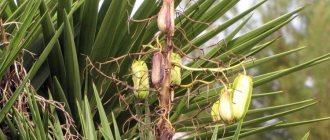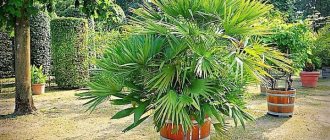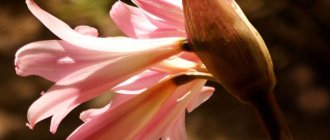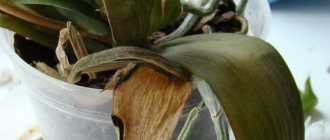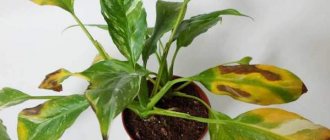Among the pink-colored cyclamens, African cyclamen is represented as a separate species. Its delicate and fragrant inflorescences appear in the spring and decorate the bush until autumn. They can be either pale pink or deep pink. Quite large, up to 15 cm in diameter, green leaves with a silvery tint grow directly from the corm.
The African variety of cyclamen is characterized by the appearance of peduncles first, and already at the end of flowering (in September) it begins to produce young leaves.
African cyclamen is deciduous and sheds its leaves during the dormant period. He rests in a cool place (no more than 15 degrees Celsius), but due to his heat-loving nature, he is very afraid of low temperatures and, oddly enough, the sun. When grown in open ground, it needs shade and additional shelter for the winter. Of all types of cyclamen, African has the fastest growth rate and develops quickly.
Free-loving alpine cyclamen
One of the wild plant species is alpine cyclamen.
For a long time it was considered extinct, but even today the flower can still be found, most often in natural conditions. The variety is characterized by the arrangement of the inflorescence petals at right angles (vertically standing), in addition, they curl slightly. Alpine cyclamen blooms in spring, emitting a delicate honey scent; the main color of the flowers is various shades of pink. The leaf blade has an oval shape and is slightly grey.
Endangered species - Colchis cyclamen
Pontic cyclamen, as this variety is also called, has recently become a plant that is protected from mass destruction.
The flower is listed in the Red Book, although its plantings are still quite large. But as a result of the active use of cyclamen for medicinal purposes and for making bouquets, its numbers are decreasing every year. Colchis cyclamen is characterized by slow growth, and the seeds ripen throughout the year. Roots grow throughout the corm, leaves grow simultaneously with the appearance of flower stalks. The inflorescences are small, pink, with a more richly colored edge, from which a strong aroma emanates. The pattern on the leaf plate is absent or weakly expressed. Pontic cyclamen prefers moist and shady places.
The flowering time of the plant depends on the growing conditions. In nature, flowering lasts no more than 1.5 months and occurs at the beginning of autumn (from September to October). At home, the bush blooms already in July and pleases the eye until mid-autumn.
Features of flowering, growth and reproduction
For many gardeners, the flowering time of cyclamen is very suitable. At this time, many plants do not bloom. So the flower carpet in the apartment is maintained.
Development at home
Under good conditions, faster and more noticeable. At all phases of development:
- Choose a suitable location;
- Choose the right pot and soil;
- Provide optimal care.
How long does it take to grow an adult plant?
about a year to grow an adult plant.
Plants bloom after sowing seeds only after a year.
Or even more time may be needed. Endurance and patience!
After growing from a divided tuber - faster.
How are varietal characteristics transmitted?
Cyclamens are propagated in two ways:
- Seeds . Not all flower growers succeed in this;
- By dividing the tuber : Select adult plants. With already fallen leaves. And with noticeable growth points;
- The sections are treated with a fungicide and allowed to dry;
- There are no problems with preserving the variety.
Reproduction by dividing the tuber.
And sowing seeds does not always guarantee the cultivation of the same variety. So they get a new variety. You can try it too.
Is it possible and how to grow from seeds?
Many gardeners grow them from seeds. Please note that good germination of seeds occurs only a year after collection . And it lasts for 5-6 years.
But it all depends on the variety. Seeds are used only those that are ripe after cross-pollination of different flowers.
What do flower stalks look like?
They don't pay much attention to them. Because of the beautiful flowers:
- Several peduncles 15-20 cm long. With one flower;
- Very often there are more than a dozen of them . On individual adult bushes, up to fifty of them are formed;
- After flowering, neat boxes with seeds are formed.
Is it possible to achieve cap flowering?
Many varieties of cyclamen can form up to 50 flower stalks . And this hat looks quite attractive.
And many flower growers strive for this. And they show off their successful examples.
Bud lifespan
Cyclamen are characterized by amicable flowering . But different types and varieties have their own characteristics. But many are pleased with their flowering from autumn until the end of spring.
The many faces of Greek cyclamen
Already from the name it becomes clear that the Greek cyclamen came to us from Greece; it also grows freely on the islands of Crete, Cyprus and on the warm coast of Turkey.
Depending on the specific variety, cyclamen can have either heart-shaped or simply oval leaves. They are painted in different shades of green; lighter spots with a characteristic pattern clearly appear on the surface. As for the color of the inflorescences, all shades of pink predominate here, and in some specimens the base is purple and slightly curved. Peduncles appear both together with the leaves and before them.
In nature, there is also white Greek cyclamen, but it is not grown at home. The white-flowered variety is listed in the Red Book.
Growing
There is an opinion among gardeners that growing cyclamen at home is quite problematic. All types fall under this statement. But this is a misconception, since purple cyclamen and other varieties, if care is correct and timely, do not require special attention and bloom beautifully on windowsills.
When growing this plant, you should remember that caring for it should begin from the moment of purchase in the store. Having brought the pot into the house, the flower must be replanted immediately. Planting is done in a slightly larger pot. This need is due to the fact that previously the plant grew in cool greenhouses, and now it will grow at home.
All types of this plant (mini, purple, delight, etc.) have two stages:
- the flowering period when flower care should be most complete. Almost all plants have a long flowering stage. Some species can produce flowers of different colors: red, pink, yellow, lilac white, etc.;
- period of rest or sleep. Here, care involves minimal watering and darkening the pot. Varieties grown at home remain dormant for 2-3 months.
If care is not sufficient, especially during the dormant period, then cyclamen may not bloom. By properly caring for this plant, you can get it to bloom regularly.
Early flowering Kos cyclamen
From the distant island of Koss a decorative species of cyclamen with the appropriate name came to us. Its lush bushes with rounded heart-shaped leaves produce flower stalks in winter or early spring. The color of the inflorescences can be very diverse: from white to rich shades of pink and even red. Regardless of the base tone, the base of the petal is always darker than the rest of the petal. The leaves themselves appear only at the end of flowering, in the fall, and the cyclamen goes to winter with them.
In Kos cyclamen, roots grow only in the lower part of the corm. It is painted in a very beautiful, rich brown color and has a velvety surface.
In children's rooms
And if the entire interior is built on a combination of bright pink and white, then it will be perceived as unfinished, but this is a very common color scheme. It is often used for children's rooms for girls and rarely successfully, more details here. In the absence of other colors, neither the beauty nor the “lively” character of hot pink is manifested, but only a house for Barbie is obtained.
When looking at such an interior, I want to ask “where is the girl?”; There is absolutely no individuality in this interior, pure pop
The glossy cyclamen pink (also Barbie and fuchsia) pairs beautifully with blue and aqua, as you can see in the photo on the left. Please note that the elements are so glossy that they even look like lip gloss.
The most frost-resistant ivy-leaved cyclamen
One of the most common types of cyclamen, which is grown in the vast expanses of our homeland, including in indoor floriculture.
Characteristic features of the plant include:
- pink color of the petals (not counting white-flowering hybrids, which do not occur in natural conditions);
- winter-spring flowering period;
- delicate aroma;
- small horns on the inflorescences;
- the rounded shape of the leaves with grooves, thanks to which it resembles ivy foliage.
superficial root system;
Ivy-leaved cyclamen (or Neapolitan) can bloom both before the leaves appear and simultaneously with their blossoming.
It would take a very long time to list the varieties of this diverse plant, and it would be impossible to remember all of its hybrids. Sometimes it is simply impossible to distinguish them from each other, and is it even necessary? They are all very beautiful, no matter when the delicate butterfly flowers bloom and what color they are painted. Let's just grow these amazing types of cyclamens on our plot or in pots and admire their beauty, because sometimes we so miss the feeling of unity with nature.
Cyclamens bloom - video
Cyclamen is an ornamental crop that is distinguished by incredibly beautiful flowering.
At this time, the buds look like “tongues of frozen bright flame.” There are many types and varieties of cyclamen. Each of them differs in height, color and care characteristics. The popularity of this lovely flowering plant has only increased recently. In indoor culture, two types are most common: Persian cyclamen and European cyclamen. Both species captivate with their lovely original flowers.
Combinations
First, I will talk about the proven combination of hot pink - with white, gray and black.
No matter how glamorous, baroque and original the interior is, built on a combination of bright pink and black (+ white or gray), this interior will be aggressively contrasting.
Therefore, experiments with oblique lines, zebra and variegated pictures in this color scheme are already unnecessary, as you can see in the photo above right.
The color looks much calmer in a less contrasting gray and white interior with black accents, as you can see in the photo above.
Contrast in such an interior is not an end in itself, but a means to achieve expressiveness and emphasize the effectiveness of the combination of bright pink and gray. There should not be many black inclusions - one or two accessories.
Without bright white and black
Finally, the most calm looking interiors are those in which hot pink is combined with gray without bright white and without black, as in the photo.
Instead of white, milky, creamy or creamy colors are used in such interiors, and this greatly softens the intensity of cyclamen or fuchsia.
Such interiors are much less tiring for the eyes than the above contrasting interiors, where the shade is combined with black.
Nevertheless, the tough decision remains popular - probably, the demand for punk glamor is stable. Every capital has a restaurant decorated in this style, and it is by no means aimed at teenagers with empty wallets.
If you decide to set the table in bright pink, black and white, keep in mind that against such a background any food will look more faded - the photo on the right clearly shows that the bright cakes themselves are greatly inferior to the table design.
So, a short summary on combining hot pink with black, gray and white .
The more contrasting such an interior is, that is, the more black, white and hot pink there is in it, the more tiring it is for the eye and the more dull colors play out against its background if they suddenly find their way into the interior.
This means that such interiors get boring faster and are updated more often.
This means that if you really want a pink, black and white interior, but you don’t have a lot of money, buy its black and hot pink elements in a low price range - throwing them away, you won’t regret wasting your money. If you are not going to change half of the interior soon, then reduce the proportion of black and increase the proportion of gray - this will make the interior much calmer.
Adding More Colors
Much more interesting solutions can be found if you place it on a white background without using gray and black and add other rich colors to it.
For example, a very cool version of a bright pink color goes well with cold shades of light green - light green, kiwi, mint. The purer and richer the light green color, the better for this combination. In the photo on the right there are not very many light green accents, but in general this combination may well be basic in the interior.
Cyclamen is a pure cool shade that goes well with bright blue and bright yellow. To combine hot pink with blue and yellow, a white background is very important, as you can see in the photo on the left.
Please note that the yellow color should be clear and clear, without orange or gray undertones.
The same applies to the rest of the colors used in the interior - they should be clean and bright, preferably from a catchy palette, which by definition includes hot pink.
With catchy flowers
It’s paradoxical, but if you use a white background for bright pink and combine it with other bright colors from a catchy palette (and it almost doesn’t matter which ones - bright green, bright yellow, pure orange, and blue will do), then the interior becomes much less tedious than interiors based on a combination of fuchsia with dark and calm colors.
In the photo you see an interior in which the white background and shade are complemented by numerous very bright accents. Compare it with the following photo.
Here fuchsia is combined with brown and gray - calm colors that go well with the least intense shades of fuchsia. However, due to this restraint, the interior looks very dull - it is saved by huge windows and a white floor, otherwise it would become completely depressing.
This property of bright pink color is demonstrated even more clearly by the photo above. Here we use a bright cyclamen pink and dark gray background + a sofa in a pleasant gray color and accessories in yellow and purple. The result is pretentious nonsense, not a residential interior.
So, an important summary on pairing hot pink .
Firstly, hot pink in the interior needs other rich colors - usually as accents, but sometimes as full-fledged basic partners. This way the interior loses its parodic character and acquires normal residential features.
Secondly, for hot pink to look good in the interior, it needs a white background, otherwise the interior will take on a depressing or downright stupid character.
So, contrary to the popular belief that there can only be one bright color in the interior, we see that hot pink, on the contrary, looks good in the company of catchy colors from its native palette.
Description of all varieties with names and photos
Caucasian
The plant is 10 cm high. Dark brown root tubers are concentrated underground and partially above its surface. Their diameter is 8 cm. Round, wintering leaves extend from them. The flowers are concentrated on long stalks. The fruits are spirally twisted. Flowering begins in February-March, and fruiting begins in March-June. Reproduction is vegetative and by seeds. If the second method is chosen, the seeds will germinate in the spring of next year.
Victoria
This variety is excellent for winter flowering. The height of the plant is 30 cm. The leaves have a unique color - light green with silver veins. Flowering begins at the end of autumn and lasts until spring. Cyclamen Victoria is characterized by double flowers. Care is simple and no different from caring for other types of cyclamen grown at home. But if left untreated, the plant will die.
Garden
This plant is presented in two types of winter-hardy cyclamens - summer and autumn alpine violet. Summer violet is cyclamen purple. Its flowering lasts from July to September. Autumn – Cyclamen Neapolitan. Its leaves are decorated with a silver pattern. Flowering begins in September. Garden cyclamens should be grown in partial shade, in a place where there are no drafts or wind. The soil should be calcareous and enriched with humus. Garden cyclamen gradually grow, multiplying independently and forming colorful clearings.
Ivy (Neapolitan, pink)
In European countries, the culture of this variety is bred as naturalization - to decorate gardens and parks. Ivy-leaved cyclamen is characterized by independent development.
This variety is one of the most frost-resistant. It differs from the rest in its jagged leaves, which are very similar to ivy leaves. On each leaf bend there are unique horns, characteristic only of this type of plant. This variety is not grown at home.
Lush flowering will begin from early to mid-autumn. The flowers are beautiful pink. The development of the root system occurs from the top of the tuber, so it is planted at a depth of 10 centimeters.
Terry
This is an indoor plant that was obtained as a result of complex selection by crossing several species (ornamental and wild varieties). Double flowers are large and form 13 petals. There are situations when 2 simple flowers are formed on one bush. It looks impressive and unusual. The leaves are different from ordinary cyclamens. They are larger in size. The plant looks very beautiful, even in the absence of flowers, when the cyclamen is in a dormant period.
Purple
This variety has become widespread in European countries. It grows both in the wild and in gardens. This is one of the northernmost cyclamens. He lacks pronounced peace. It remains with leaves throughout the year.
Flowering occurs in summer and lasts until mid-autumn. The height of the plant is 10 cm and the width is 8 cm. The leaves can be round or heart-shaped. Their surface is glossy, dark green in color, up to 8 cm long. The flowers, curved upward, are distinguished by their aroma. Their color ranges from pale carmine to red. Flowers bloom in mid-summer.
Kossky
This flower received this name in honor of its homeland, Kos Island. Some of its populations can be found almost all over the world. The tubers of the plant are velvety to the touch and have a dark brown color. The development of the root system occurs from the lower region of the tuber. The leaves appear in the fall and are covered with snow throughout the winter.
Taking into account the place of growth, the color of the flowers is subject to change:
- on the Black Sea coast near Turkey - bright pink color;
- in Syria and southern Turkey - pale pink color.
Diseases and pests
The main causes of plant diseases:
- Excess water in the pan during the dormant period.
- The room is too hot.
- The soil is incorrectly selected.
- Lack of light or vice versa – excess.
- Dry air.
Pests have existed and will always exist on our planet, but the owner of cyclamen can help his plant cope with their negative impact.
The most annoying ones are:
Cyclamen mite .
It is almost impossible to see with the naked eye - it is so small, but the damage it causes is very significant. A colony of adult mites covers the inner surface of the leaf and fills the folds of flowering buds, resembling islands of either dust or mold.Ticks grow in hot rooms with high humidity. Over time, the growth of the plant slows down, the leaves turn yellow at the edges, curl and fall off. If rescue measures are not taken, these harmful insects will destroy the flower in 2-3 weeks.
Treatment regimen:
- The flower is isolated from other plants.
The pot with the plant is immersed in a bowl of water for 15-20 minutes. To maintain a constant temperature of +45 degrees, hot water is constantly added to the container.
- Damaged parts are removed
- Cyclamen is left in a dark place for two days.
Thrips .
These nimble bugs fly from one leaf to another, leaving behind traces in the form of sticky silvery streaks. The reason for the thrips invasion: low air humidity coupled with hot weather. Until the cyclamen becomes covered with through holes and dies, the owner needs to treat his green pet with an insecticide (Apache, Arrivo, Akarin in the proportion of 5 ml of the drug per half liter of warm water), and buy special trap tapes for the future.- Aphid sucks out all the juices from the soft tissues of the plant, as a result of which cyclamen stops growth, its leaves curl and dry out. If you look closely, you can see many skins that have been shed by moulting insects.
Aphids can be easily controlled in the first stage of the disease.Even a novice florist can do this:
- Accumulations of aphids from buds and leaves are removed with a cotton swab dipped in a solution of green soap or garlic infusion.
You can use any other folk remedy.
- The plant is processed by Aktar or Commander according to the instructions.
Shield .
This parasite instantly seizes new territories and destroys cyclamen in two weeks. Folk remedies are practically powerless here. Even insecticides sometimes fail. This happens because insects that sense danger can temporarily change their habitat - fly to another plant and return in a week, two or a month. Therefore, alternating treatments with Aktara and Aktellik 3-4 times in a row with a frequency of 2 weeks are required.
The disease is easier to prevent than to treat . It is important for a florist to remember two things: prevention and compliance with growing recommendations.
General rules of care
Air humidity
Cyclamen is a plant for which high humidity is important. During growth, the leaves should be sprayed. Stop spraying when flowering begins. To increase humidity levels, you need to create a water mist near the flower. To do this, place it on a tray with wet pebbles. With the onset of winter, place it at a great distance from central heating radiators.
Watering
During flowering, water the plant so that the liquid does not penetrate the roots. Distribute the moisture evenly to avoid overflow. But the soil should not dry out either.
Transfer
It is advisable to transplant when new leaves form on the plant. This falls at the end of June. For transplantation, use a low container that is quite wide. When performing a transplant, take into account the following point: the root system of cyclamens is completely covered with earth. Until the roots are thoroughly established, water infrequently, and only then increase the moisture.
Feeding
Fertilizers must be applied once every 2 weeks. It is necessary to use mineral compositions intended for flowering crops. Apply fertilizers from the moment the leaves develop and continue until the plant blooms.
Diseases and pests
Cyclamen is very often affected by infectious diseases and pests.
Most often it is attacked by the cyclamen mite. It can be detected by the presence of deformed leaves, crooked peduncles and curved buds. Detecting a tick infestation in the early stages is not easy. In case of severe damage, drugs do not always cope with parasites, so you will have to get rid of the flower. Among the diseases, the plant is affected by gray rot and powdery mildew. These are fungal diseases. If the leaves begin to curl and dry out, then an urgent need to treat with Fudnazol.
Cyclamen is an ornamental plant, the peculiarity of which is that it can be grown at home and in open ground.
Does not make any special demands on the type of soil and is not picky about care.
But if you make a number of mistakes, this is fraught with the development of diseases that can ruin the flower.
If you find an error, please select a piece of text and press Ctrl+Enter.
Cyclamen or dryer is a perennial herbaceous plant of the Myrsinaceae subfamily, Primrose family. The homeland of the flower is considered to be the Mediterranean coast, Asia Minor and North-East Africa. Types of cyclamen have different names, which depend on where the flower grows. We will talk about some of them in more detail.
Cyclamen care
There is an opinion that cyclamen is very capricious and demanding to care for. But in reality, not everything is so scary and the needs of a Mediterranean guest are very easy to satisfy. It’s just that, unlike its tropical counterparts, it requires not heat and sun, but coolness and peace!
Temperature
Cyclamen categorically does not tolerate high temperatures and quickly dries out and falls off. The normal regime needed for growth and flowering is in the range from 10 to 14 degrees. This is especially true for varieties that bloom in winter. But in the summer, when there is no flowering, they can easily withstand +20.
Photo: lkard-lk.ru
Lighting
Cyclamen prefers partial shade at home, because direct sunlight will burn the delicate leaves. Choose an eastern or western window sill, or move the flowerpot away from the window on the south side. But in the north there may not be enough sun.
Photo: deborahsilver.com
Watering
Cyclamen is watered only with settled water that has stood for at least a day. It should be soft and 1-2 degrees cooler than the temperature in the room. During flowering, water the flowerpot more often so that the substrate does not dry out, but also so that the water does not stagnate.
For cyclamen, watering is well suited not from above, but through a tray of water. This way, moisture will not get on the stem, leaves and tuber, which means there is less chance of rotting. But do not let the water stagnate in the pan for a long time and drain the excess after 2-3 hours.
If the room has low humidity, occasionally spray the leaves with well-settled water from a spray bottle. After the buds set, pour wet expanded clay, pebbles or peat into the tray. When the cyclamen fades, reduce watering until the foliage dries and the tuber is exposed - this is a dormant period.
Photo: waysi.ru
Rest period
Cyclamen that has bloomed and dried out should be moved to a cool and well-ventilated place out of the sun. For example, on the balcony, where it is enough to occasionally moisten it a little. At the end of summer, move the flowerpot to a bright, warm room and begin to gradually increase the intensity of watering.
Photo: en.vomturmhaus.com
Fertilizers and fertilizing
Cyclamen should be fed only during the period of active growth, when the leaves are just beginning to hatch. Organic and mineral fertilizers are suitable, but do not overdo it with nitrogen. It can cause rotting of the root system.
Photo: skolkogramm.ru
Transplantation and propagation
Cyclamen needs to be replanted every year in late summer or early autumn. At this time, the tuber comes out of dormancy and the first leaves appear. When replanting, cut off all rotten and damaged roots so as not to injure healthy ones. The tuber must be at least a third above the ground level for the flower to be thick and lush.
Photo: domashniecvety.ru
Coleus (60 photos): types and features of care
Persian
Persian cyclamen (Cyclamen persicum) is a widespread plant in some countries of Asia, Africa and Western Europe (Sudan, Ethiopia, Italy, Cyprus, Iran).
This type of cyclamen grows comfortably in countries with moderately cool winters, for example, in northern Italy, and even blooms in winter.
The plant stores many organic and mineral substances in its tuber. During the inactive phase, it feeds on these substances. In the wild, if the woody tree blooms in winter, it especially needs organic matter.
Dutch breeders have developed many hybrids of Persian cyclamen. Hybrids have a longer flowering period.
Agricultural technology
Rest period
Catharanthus flower: home care and methods of propagation
When cyclamen is bred, growing and caring for it at home is not complete without a period of rest. Its onset is associated with the drying and dying of cyclamen leaves. Inexperienced gardeners often get rid of the plant. They believe that cyclamen is a disposable crop that is not capable of blooming every year.
It is advisable to reduce the frequency and intensity of moisturizing. It is recommended to carry out the procedure gradually. When the crop is completely exposed, watering is carried out rarely and little by little.
When shedding the last flowers, you will need to remove the wilted buds and old dried leaves. In spring, the crop is placed in a damp place and the water is stopped for a while.
When does the rest period begin?
During the dormant period, storing cyclamen at home is carried out in a different way: when the bush fades, reduce irrigation; when the foliage dies, the flowerpot is turned 90°. So the plant is stored until the end of summer or the beginning of the autumn season.
When faded flowers are removed, they prolong the flowering time and help the formation of new buds. Correct execution of the manipulation is required. It is forbidden to pick or trim old flower stems and foliage. They are unscrewed near the tuber, carefully, avoiding damage. If damage occurs, they are sprinkled with activated carbon.
Flower transplant
The planned replanting of cyclamen at home is carried out after 3 years. The procedure is determined by the type of plant: the European species is replanted with the arrival of the spring season, and the Persian species is replanted in the fall. The transshipment method is suitable for manipulation. The culture is transferred to a new pot with an earthen lump covered with roots. Just add soil to the large pot. Remember the drainage layer.
Transshipment is a popular way to transplant cyclamen
If you are replanting flowers from a store, carefully clean the roots from the old soil. Fill a new container with substrate for bulbous crops (Florin, Tulip). Use slightly acidic soil. For a young seedling, a pot with a diameter of 7-8 cm is suitable, for a three- or five-year-old flower - 14-15 cm.
The European tuber is completely covered with soil when planting; the Persian tuber is only 2/3 covered. When the soil is of good quality, there is no need to fertilize the crop for 1-2 months.
Temperature
Cyclamen grows normally and blooms luxuriously in winter, when the temperature is +10...+14 °C. In the warm season, the ideal temperature for a flower is +20...+25 °C.
Watering
When caring for it, it is important to know how to water cyclamen correctly. You will need soft water, which is 2 degrees lower than room water. Before watering, it is allowed to sit for a day. Intense moisture is characteristic of the flowering period.
Prevents overdrying of the substrate in the flowerpot and stagnation of liquid. Bottom watering, which is carried out in a tray, is suitable for the plant - moisture will not get on the buds, nodules, or the core of the bush. After moistening the culture, after 3 hours, remove excess liquid from the pan.
Watering cyclamen
When flowering ends, moisture is reduced. If the leaves completely wither, the tubers become exposed; watering is infrequent and insignificant.
The soil
When planting crops, they use purchased soil. A universal soil is suitable for geraniums or saintpaulias.
Soil for cyclamens
The addition of sand and perlite adds friability and moisture retention. The soil for planting cyclamen is suitable with a neutral or slightly acidic pH level. If desired, you can prepare it yourself. You will need sheet soil (3 parts) and peat, manure, sand (1 part) taken in equal proportions.
The soil from the site is disinfected by calcination in a microwave oven or by pouring a solution of potassium permanganate. Expanded clay along with gravel and pebbles is used for the drainage layer at the bottom of the container.
Containers for cyclamen will be made of ceramic or plastic.
For adults, dishes with a diameter of 14-15 cm are useful, for young seedlings - less. Select dishes for the plant depending on the size of the nodule. The distance from the edge of the onion to the edge of the flowerpot is 2 cm. This will ensure optimal development and timely flowering for the indoor plant.
Lighting
If you grow cyclamen, there are tips on how to care for them correctly. To fully develop, culture requires light. Direct sunlight often poses a threat to the plant. A window sill in the west or east is suitable. When placed on the south side, a place further from the window or shading is preferable for the flower. The north side is not a suitable place for cyclamen.
European
The European cyclamen plant (blushing) is widespread in Central European countries (northern Italy, Slovenia, Macedonia).
This is a herbaceous evergreen plant with a flat-round tuber (it is slightly flattened with a single growing point). With age, the tuber of the flower becomes deformed and produces thick shoots that have their own growth points.
The leaves of this type of dryer are basal with a silver-green color. They are heart-shaped with a pointed tip and a slightly jagged edge.
The underside of the leaves is purple-green. The flowers are five-petaled, solitary, with very long peduncles. The petals are oval shaped and slightly twisted into a spiral. A special feature of the European dryer is its sharp and delicate aroma.
Flowering continues throughout the growing season - from spring to autumn . The color of the flowers varies: light purple, pale pink, bright purple, pink-violet.
Breeders have developed several forms of European cyclamen, which differ in the flowering period and color of the flowers.
The following varieties are popular among many gardeners: purpurascens (purple-pink flowers), carmineolineatum (white flowers), lake garda (pink flowers), album (white flowers).
African
Cyclamen is divided into different types and subspecies (varieties), but one of the most common and popular types is African .
The bush thickets of Tunisia and Algeria are considered the birthplace of the African dryer. According to the botanical description, this type of plant is similar to the ivy-leaved cyclamen. There are two forms of African cyclamen: diploid and tetraploid.
The diploid form of African dryweed has smaller leaves with different petiole shapes and more fragrant flowers. For decorative purposes, it is customary to use the diploid form of African cyclamen.
History of appearance
The cyclamen flower was known in Ancient Rome as a decoration for the yard and home, a remedy for illnesses and a talisman.
The popularity of cyclamen began to grow in 1939. In Ontario, a Canadian province, Lloyd Veit, a resident of Delhi, opens a small business - a flower shop. Formerly Flowers is one of the largest flower suppliers in North America today.
Cyclamen in the interior of the house
Farmley Flowers grows year-round flower products that bloom in autumn with a rainbow of colors with the appearance of graceful cyclamens.
Cyclamen appeared in European countries in 1650. This period is characterized by the creation of hardy hybrid varieties and the cultivation of plants everywhere.
On a note. There are cyclamens that look unusual: two-colored, with a border or frill. Breeders are successfully working, delighting flower growers with new unusual hybrid varieties.
A variety of varieties delight gardeners
Alpine
Alpine cyclamen has a very vague history. At the end of the 19th century, Cyclamen alpinum was discovered and included in the list of plants of the Myrsinaceae subfamily.
But over time, some plants disappeared in cultivation; until 1956, the alpine tree weed was considered an extinct species. The epithet "alpinum" has long been used to refer to cyclamen intaminatium.
There was some confusion in terms, botanists decided to introduce a new name for the Alpine tree weed - cyclamen trochoteraptum. This term is still used by many scientists today, although in the early 60s Davis confirmed that Cyclamen alpinum had not disappeared.
At the beginning of 2000, 3 expeditions were sent to study this type of dryer. The expedition participants confirmed that alpine cyclamen grows in the wild to this day.
The main difference between this type of plant is the angle of the flower petals (90º instead of the usual 180º ). The petals are slightly curled and look like a propeller.
The petals range in color from carmine pink to pale pink with a purple-violet spot at the base of each petal.
The aroma of the flowers is very pleasant and delicate, reminiscent of the smell of fresh honey. The leaves of the alpine tree are oval in shape with a characteristic gray-greenish color.
Cyclamen persica
Cyclamen persica
By popularity - number one on the list. It is he who comes to mind first when talking about this plant. It has been used in culture since the 16th century, but became widespread in the 19th century. From this period, intensive selection began, the leaders of which were the British and the Dutch.
Persian cyclamen is larger than its counterparts. It grows up to 30 cm, flowers reach 5 cm in diameter. The round tuber is flattened, up to 15 cm in diameter, the roots grow at the bottom of the tuber.
Depending on its natural habitat, the flowering time of Persian cyclamen is December-May. The color scheme of natural specimens is most often light pink or crimson. But thanks to the successes of modern breeding, today you can buy or grow hybrids and varieties with flowers ranging from snow-white to dark purple. Plants with bicolor flowers have also been bred.
Growing Persian cyclamens
The numerous collection of varieties delights and makes you fall in love at first sight. Several hundred varieties and hybrids of Persian cyclamen are divided into groups according to different characteristics.
According to height they are distinguished:
- Standard plants . They grow up to 30 cm. They are grown in pots with a diameter of 13–20 cm.
- Intermediate . Their height ranges from 20–25 cm. Containers with a diameter of 10–13 cm are suitable for them.
- Miniature ones do not exceed 15 cm. They are grown in pots 6–10 cm wide. This group contains the most aromatic plants. Despite the fact that the leaves of mini cyclamens are small, their flowers reach 4 cm in diameter. Leading Western manufacturers rely on this group. They strive to create compact, strong plants with small leaves and fragrant flowers of different shapes and colors.
Flowers of different varieties can be simple, double, or fringed.
Popular varieties
Plants of the Umbrella have pink flowers with an unusual shape, similar to an open umbrella.
Cyclamen variety "Lulu" grows up to 20 cm. It has simple large flowers of salmon-red color with a fringed edge.
The height of the plant of the Aurora is only 15 cm. The flowers are pink with a pleasant smell.
The Victoria variety is very popular It features simple flowers with a fringed edge. The petals are bicolor - white with a crimson base and border.
The “Rococo” includes cyclamens with double and fringed flowers of different colors.
"Rococo Pink" and "Rococo Rose" have pink flowers. ' Rococo white' white flowers with a pink center.
Luxurious cyclamens of the “Rococo Lila” . Their bushes are compact, 15–20 cm high. On strong peduncles there are large purple flowers that look like fluttering butterflies.
Cyclamen persica striata
The cyclamen variety “Striata” is memorable. It is also short - 15–20 cm. Its foliage is dark green with a subtle silvery pattern. The flowers are bicolor - white with purple streaks and a pleasant scent.
Colchian (Pontic)
The Caucasus Mountains are considered the homeland of this plant species. The Colchis drake is also called Pontic, Caucasian or Abkhazian.
At home it blooms from July to the end of October, in the wild - from early September to mid-October. Often found in the mountains at an altitude of 300-800 m among the roots of trees.
The flowers of the Pontic dryer appear along with the leaves. The petals are dark pink (darker at the edges), elliptical in shape, slightly curved, 10-16 mm in length.
The entire surface of the tuber is covered with roots. The plant loves shady areas with moist soil. The flower grows very slowly, but has a sharp and pleasant smell. Seed ripening takes a whole year.
At the moment, the number of this species is still quite large, but botanists say that it is noticeably decreasing every year.
Popular varieties for home growing
An interesting interior of rooms is impossible without cyclamens. Suitable for placement in the hallway, dining room, kitchen, bedroom, living room. However, not all varieties will take root in the house, but only some cultivated ones. Frequent guests in the home are:
| Kinds | Description |
| European (Alpine violet) | A colorful plant with large flowers and succulent leaves. What shades are there? A lilac-pink palette is often found. Flowering time - early spring - late autumn. There are varieties that are ready to delight with flowers even throughout the winter. The rest period is limited. |
| Persian (Dryakva) | Pink and white tones predominate. The leaves are green-silver, regular, heart-shaped. Blooms from November to June. The most popular varieties are dwarf ones. Propagated by seeds. |
| Alpine (Trochoteraptum) | A distinctive feature is that the flowers and petals are located at an angle of 90 degrees, and not 180 degrees, like other varieties. What shades are there? From light pink to purple. The smell is delicate, quite pleasant, honey. The leaf blades are oval-shaped, gray-green in color. |
| African | Natural habitat - Tunisia and Algeria. They prefer bushes. There are two forms: diploid and tetraploid. At home, the diploid form is most often found. The leaves are heart-shaped, silver-greenish in color. Light or deep pink flowers delight the eye from spring to autumn. Experts advise taking the purchase of such a plant seriously. It contains toxic components that negatively affect the general condition of dogs and cats. |
| Colchis (Pontic) | Often found in the Caucasus mountains. Flowering time at home is from July to October. Flowers and leaves appear simultaneously. The petals are slightly curved. The color is dark pink, the length is from 1 to 1.6 cm. The roots are located over the entire surface of the tuber. Features of care are the presence of a shaded area and constant soil moisture. It grows slowly. The flowers are fragrant. Used to decorate bouquets. |
| Kossky | Natural habitat - Bulgaria, Syria, Georgia, Iran, Turkey, Lebanon. The leaves are colored green or dark silver. The color of the petals is multi-colored: pink, red, white, purple. |
| Greek | They grow on the islands of Crete, Rhodes, Cyprus, as well as in Turkey and Greece. They love moist, shaded areas. The leaves are heart-shaped or oval, pale green or dark green in color. The predominant shade of the petals is pale pink. |
| Cypriot | The main place of growth is mountains. Prefers rocky soil and shaded areas. The height is 8 – 16 centimeters. The smell of white and pink flowers is pleasant, honey. The leaf blades are heart-shaped. How does it bloom? From September to February. |
| Ivy (Neapolitan) | A distinctive feature is frost resistance. Ideal for growing at home. The leaves are green, round, reminiscent of ivy. The flower is equipped with attractive horns. The root system is of superficial type. Petals are pinkish. Mini-cyclamens bloom from December to March. The best producers have filled the market with plants with a strong but pleasant smell and interesting colors. |
Greek
The Greek drab is found on the Greek mainland, the islands of Rhodes, Cyprus, Crete and on the coasts of Turkey. Observed at altitudes up to 1200 m above sea level. Grows in shady and damp places.
The leaves of this plant have a wide variety of shapes: from heart-shaped to oval.
The color of the leaves varies from dark green to light lime green with characteristic contrasting spots of cream or light gray.
The flowers of Greek cyclamen appear either before the leaves or together with them. Flower color varies from pale pink to carmine pink. Bright purple spots can be observed at their base.
In 1980, a rare subspecies of the Greek dryer with white flowers was discovered on the Peloponnese peninsula; it was listed in the Red Book.
Reproduction techniques
Tubers
Before propagation, the flower tuber must be dried. When making a cut, the location of the root along with the buds and leaves on each lobe is important. The cutting area is smeared with brilliant green or sprinkled with activated carbon, then allowed time to dry (2 days).
Propagation by tubers, treatment with brilliant green
Plant the parts in moist soil, place them in a lighted place and ensure regular watering. Adaptability is not 100%; some of the cuttings rot.
Seeds
Artificial pollination will allow you to stock up on seed material from indoor cyclamen. The manipulation is effective when performed on a sunny morning, and repeated several times.
Obtaining seeds
Attention! Drying the seed after collection has a negative impact on germination. The quality of seeds on sale depends directly on the batch.
Before planting in the soil, seed material is soaked in Zircon for 24 hours (4 drops per 500 ml of liquid). To grow seedlings, you will need light, loose soil. The soil mixture requires a container with holes in the bottom. First, pour a 3 cm expanded clay layer. Sprinkle prepared soil on top (6-7 cm). The earth is moistened abundantly. The seed is placed on the surface in 2 cm increments and sprinkled with a little soil. The container is covered with film. Sprouts wait from 1 to 3 months.
Cyclamen shoots
The soil needs watering and ventilation. First, a purple-pink nodule forms on the surface. When a pair of leaves grows, the seedlings are picked and placed in individual containers. After 7-14 days, it is advisable to feed with complex fertilizer. They expect cyclamen to bloom for a year. Flowers cultivated at home are distinguished by their endurance and health compared to purchased ones.
If cyclamens are grown, proper care is required. Familiarization with the description of the flower and the nuances of cultivation and propagation will help beginners decorate the interior of the house and preserve its decorative properties for a long time.
Kossky
In the Aegean Sea there is a certain island of Kos, after which this type of cyclamen is named. The plant is found in mountainous and coastal regions of Bulgaria, Georgia, Lebanon, Syria, Turkey, Ukraine and Iran.
Kosskaya drakva blooms at the end of winter or early spring. Foliage appears in late autumn and sometimes in winter.
Depending on the plant variety, the foliage can be either green or dark silver. Flower colors vary: pink, purple, red, white.
The bases of the petals are always brightly colored. This type of flower is characterized by tubers with roots that grow only from the bottom.
Certain patterns are observed in the size of flowers, changes in the color of petals and the shape of leaves: light pink flowers and kidney-shaped leaves in plants from southern Lebanon and Syria, bright pink color of flowers is characteristic of cyclamen from the northern coast of Turkey, further to the east the leaves become narrower, and the flowers are larger.
Heart-shaped leaves with large flowers are observed in the southern regions of Iran and Azerbaijan.
Growing cyclamen
Depending on the method of propagation, cyclamen is grown from seeds and from tubers. Each type of transformation of a part of a plant into a full-fledged flower requires effort and special care.
When growing cyclamen from seeds, it is necessary to create a small greenhouse immediately after planting. The container with the seedlings is watered a little and covered with plastic wrap. The optimal temperature for growing dryer from seeds is approximately +20° C. It is important to regularly water and ventilate the seedlings.
Pink cyclamen
After a month or a month and a half, sprouts appear; the planting needs to be moved to a cooler, but no less bright place. As soon as the seedlings grow small tubers and 3-4 leaves, they need to be transplanted into separate pots. Cyclamen grown from seed begins to bloom only one and a half to two years after emergence from the sprout.
Growing cyclamen from a tuber is not so easy, because in most cases the bulb rots. However, for the attempt to be successful, all breeding conditions must be met. Immediately after planting, the tuber is watered lightly and a greenhouse is created by covering the pot with a plastic glass or film. After 3-6 weeks, small sprouts appear and should be grown in the same way as sprouts grown from seeds. Cyclamen, grown from a tuber, begins flowering after a year and a half.
Garden cyclamen
Cypriot
Cyclamen Cyprus is one of three species of plants of the Myrsinaceae subfamily that are found on the island of Cyprus. It is most often observed in the Kyrenia and Troodos mountains at an altitude of 100-1100 m above sea level.
Grows on rocky soils in bushy areas or under trees. Perennial plant, 8-16 cm high.
The flowers of the Cypriot dryer are pale pink or white with a characteristic honey aroma. Violet or purple spots are observed at the base of the petals.
The leaves are heart-shaped. Color varies from dark green to olive. Cyprus cyclamen blooms from late September to mid-late winter. This flower is the symbol of Cyprus. As an ornamental plant, it is grown in many countries around the world.




